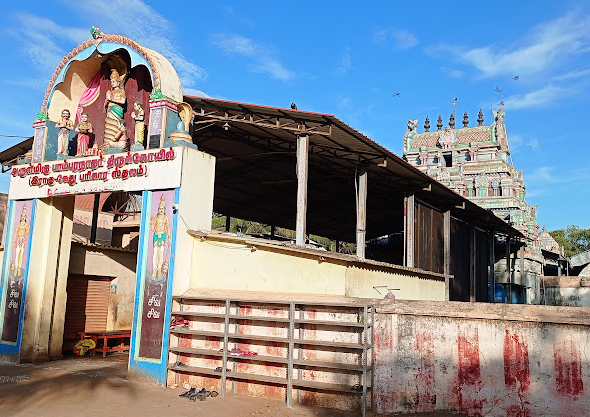Origins and Historical Significance :-
The temple is believed to have existed before the 7th century, as evidenced by hymns sung by Thirugnanasambandar in praise of Lord Shiva. The original structure was reconstructed as a stone temple during the Chozha period, with subsequent expansions carried out during the Pandya and Maratha periods.
- Inscriptions and Contributions
The temple has numerous inscriptions from the reigns of Chozha kings such as Rajarajan-I, Rajendra Chozhan-I, and Kulothunga Chozha-III, recording various contributions and events. Kulothunga Chozha-III’s inscriptions document the establishment of shrines for Thiruvasura Nayanar, Periya Devar, and Nachiyar by Udayal, a Devaradiyar. Financial transactions, including donations of kasu (currency) and land, were recorded for worship and maintenance. A notable inscription details the commissioning of the Rajaraja Vinayakar shrine by a fisherman, Kunavayiludayar Meenavan Mooventha Velalar, along the banks of the Arasalaru River. Contributions during the Pandya period included the resolution of tax dues through the sale of properties to the temple, while Rajarajan-III recorded donations for naivedyam offerings and the construction of a cowshed. Kulothunga Chozha-III’s records also highlight a severe drought during his reign, where a vellalan sold himself and his daughters as slaves to the temple. Contributions from Maratha King Sarabhoji’s period include the construction of a Vasantha Mandapam by Manuko Panditharayan, a representative of Subedar Ko Panditharaiya.
- Recent Renovations
The temple underwent significant restoration through Maha Kumbhabhishekam ceremonies held on September 11, 2002, and April 10, 2017, ensuring the preservation of its architectural and spiritual heritage.
Puranic Significance :-
When Lord Vinayaka offered His pranams to His father, Lord Shiva, the snake coiled around Shiva’s neck grew proud, feeling honoured by Vinayaka’s worship. In His anger, Shiva cursed the entire snake community to lose their poison power due to the arrogance of one snake. The Ashtama Nagas, the eight great serpents, appealed to Lord Shiva, arguing that it was unjust to curse the whole community for the actions of a single snake. They also sought forgiveness for the proud serpent.
In response, Lord Shiva instructed the Ashtama Nagas—Aanandhan, Vasuki, Dakshakan, Karkodakan, Sangabalan, Kuligan, Padman, Mahapadman, and others, led by the divine snake Adishesha—to gather at Thirupampuram on Maha Shivrathri. There, they would be pardoned and relieved of the curse.
Additionally, there is another significant event associated with this place. In a fierce contest to prove their strength, Vayu, the wind god, broke mountains with his might. However, Adishesha intervened, preventing the mountains from crumbling. Angered by this, Vayu ceased the supply of oxygen, threatening the existence of life. In response to the Devas’ pleas to save the world, Adishesha withdrew from the contest and came to Thirupampuram, where he worshipped Lord Shiva, seeking His forgiveness.
